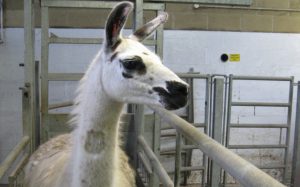Last month, we shared with you how a llama herd at Reading was helping to find treatments for COVID-19. CONNECTED now brings you a fascinating update – early research has shown that llama antibodies can neutralise the virus.
A herd of llamas at the University of Reading, which are looked after by expert handlers, are being used to produce specialist nanobodies – very small antibodies – which scientists had hoped may be able to block the virus from developing COVID-19 in humans. Lab tests have shown that these hopes were well founded, as engineered llama nanobodies do indeed neutralise the SARS-CoV-2 virus.
Nanobody technology
In a paper published in Nature Structural & Molecular Biology, a team of UK scientists have shown that engineered nanobodies taken from a library of llama blood cells bind tightly to the spike protein of the SARS-CoV-2 virus, blocking it from entering human cells and stopping infection.
 The scientists are now screening antibodies from Fifi, one of the llamas based at the University of Reading, taken after she was immunised with harmless purified virus proteins. The team are investigating preliminary results which show that Fifi’s immune system has produced different antibodies from those already identified, which will enable cocktails of nanobodies to be tested against the virus.
The scientists are now screening antibodies from Fifi, one of the llamas based at the University of Reading, taken after she was immunised with harmless purified virus proteins. The team are investigating preliminary results which show that Fifi’s immune system has produced different antibodies from those already identified, which will enable cocktails of nanobodies to be tested against the virus.
Professor Gary Stephens, from Reading’s School of Pharmacy, who leads the work on producing llama nanobodies, said:
“The search is on for effective treatments to combat the unprecedented COVID-19 pandemic. Given the lengthy development process for vaccines, one major immediate priority is the development of selective antibodies that can neutralise the SARS-CoV-2 virus responsible for COVID-19. A particularly exciting new advancement is the recent development of ‘nanobody’ technology.
“Nanobodies are smaller, more stable types of antibody taken from the immune systems of camelid species – such as llamas, alpacas and camels. Due to their smaller size, they are more able to target relevant proteins and stop the virus from attaching to a host and spreading.
“At the University of Reading, we are currently working with The Rosalind Franklin Institute to generate llama nanobodies that bind to proteins in the SARS-CoV-2 virus, including the ‘spike’ glycoprotein that enables the virus to enter human cells. These nanobodies may provide additional capacity to bind SARS-CoV-2 proteins at different sites and neutralise the virus even more effectively.”
Stopping the spread of COVID-19
Using advanced imaging with X-rays and electrons, the team of UK scientists – including researchers from The Rosalind Franklin Institute, the University of Oxford, Diamond Light Source and Public Health England – have also identified that the nanobodies bind to the spike protein in a new and different way to other antibodies already discovered.
Professor James Naismith, Director of The Rosalind Franklin Institute and Professor of Structural Biology at the University of Oxford, said:
“These nanobodies have the potential to be used in a similar way to convalescent serum, effectively stopping progression of the virus in patients who are ill. We were able to combine one of the nanobodies with a human antibody and show the combination was even more powerful than either of them alone.
“Combinations are particularly useful since the virus has to change multiple things at the same time to escape; this is very hard for the virus to do. The nanobodies also have potential as a powerful diagnostic.”
Professor David Stuart, from Diamond Light Source and the University of Oxford, said:
“The electron microscopy structures showed us that the three nanobodies can bind to the virus spike, essentially covering up the portions that the virus uses to enter human cells.”
Working together
This research is a prime example of effective teamwork across a range of scientific and educational institutions.
Professor Ray Owens from the University of Oxford, who leads the nanobody program at The Rosalind Franklin Institute, said:
“This research is a great example of teamwork in science as we have created, analysed and tested the nanobodies in 12 weeks. This has seen the team carry out experiments in just a few days that would typically take months to complete. We are hopeful that we can push this breakthrough on into pre-clinical trials.”
Discover more about how research at the University of Reading is helping in the fight against COVID-19.




